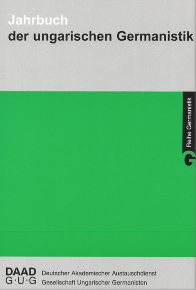Jahrbuch der ungarischen Germanistik 2024, S. 234–248.
Nichtbinäre Identität und Facework. Eine interaktionale Kommentaranalyse
Eötvös-Loránd-Universität Budapest
Diese E-Mail-Adresse ist vor Spambots geschützt! Zur Anzeige muss JavaScript eingeschaltet sein!
DOI: https://doi.org/10.69962/JUG.2025.15
Abstract:
This article contributes to the German studies literature on non-binary identity. Drawing on Goffman‘s (1967) and Motschenbacher‘s (2010) theories of „face“ and „gender face“, it examines which facework practices are used to maintain or threaten the gender face of a non-binary person. For this purpose, a report on YouTube was selected and the facework strategies of the channel, the journalist and the non-binary person were analyzed. The aim of the study is to identify facework strategies used by these agents and to look for practices that go beyond the dichotomy of correct and incorrect gendering practices. The analysis found that the strategies used focus on linguistically affirming expressions, politeness norms, the containment of transphobia and the praise of personal characteristics.
Keywords:
non-binary, facework, gender face, YouTube, nichtbinär
References:
Blake, Khandis/Godwin, Megan/Whyte, Stephen (2020): „I sexually identify as an Attack Helicopter“. Incels, trolls, and non-binary gender politics online. In: First Monday 25 (9), [o. S.] https://doi.org/10.5210/fm.v25i9.10601.
Brown, Penelope/Levinson, Stephen C. (1987): Politeness. Some universals in language use. Cambridge: Cambridge Press 7 (= Studies in Sociolinguistics 4). https://doi.org/10.1017/CBO9780511813085.
Goffman, Erwing (1967): On Face-Work. An Analysis of Ritual Elements in Social Interaction. In: Ders.: Interaction Ritual. New York: Doubleday, S. 5–45. https://doi.org/10.4324/9780203788387.
Kalwa, Nina (2022): Uneindeutiges vereindeutigen. Zur sprachlichen Hervorbringung nicht-binärer Geschlechtsidentität. In: Zeitschrift für Literaturwissenschaft und Linguistik 52, S. 651–667. https://doi.org/10.1007/s41244-022-00273-z.
Lind, Miriam (2022): Liminalität, Transdifferenz und Geschlecht. Sprachliche Praktiken jenseits von Zweigeschlechtlichkeit. In: Zeitschrift für Literaturwissenschaft und Linguistik 52, S. 631–649. https://doi.org/10.1007/s41244-022-00272-0.
Löhr, Ronja (2022): „Ich denke, es ist sehr wichtig, dass sich so viele Menschen wie möglich repräsentiert fühlen“. Gendergerechte Sprache aus der Sicht nicht-binärer Personen. In: Diewald, G./Nübling, D. (Hg.): Genus – Sexus – Gender. Berlin/Boston: de Grutyer, S. 349–379. https://doi.org/10.1515/9783110746396-012.
Motschenbacher, Heiko (2010): Language, Gender and Sexual Identity. Poststructuralist perspectives. Amsterdam/Philadelphia: John Benjamins. https://doi.org/10.1075/impact.29.
Peirce, Kimberly (1999): Boys Don‘t Cry. Vereinigte Staaten: Searchlight Pictures/The Independent Film Channel Productions/Killer Films.
Pusch, Luise F. (1984): Das Deutsche als Männersprache. Diagnose und Therapievorschläge. In: dies.: Das Deutsche als Männersprache. Aufsätze und Glossen zur feministischen Linguistik. Frankfurt a. M.: Suhrkamp, S. 46–68.
Reporter (10.02.2021): Nicht männlich, nicht weiblich: Marcel-Jana ist nicht-binär | reporter [Video]. YouTube. https://www.youtube.com/watch?v=ZhsEhgwkAKc (letzter Zugriff: 01.10.2024).
Rieder, Bernhard (2015): YouTube Data Tools (Version 1.42) [Software]. Verfügbar unter https://ytdt.digitalmethods.net (letzter Zugriff: 01.10.2024).
Zimman, Lal (2019): Trans self-identification and the language of neoliberal selfhood. Agency, power, and the limits of monologic discourse. In: IJSL 256, S. 147–175. https://doi.org/10.1515/ijsl-2018-2016.
